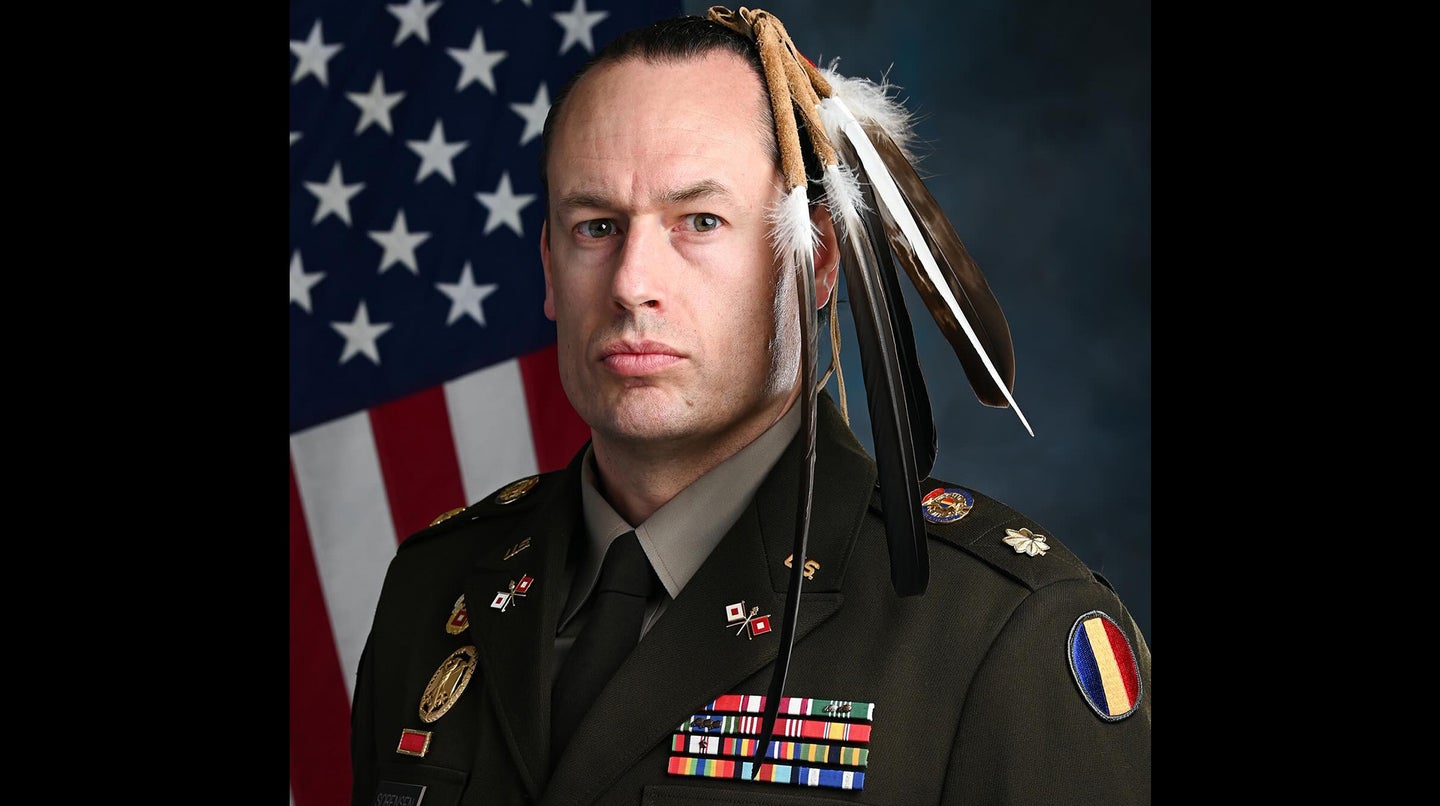Army major honors fallen soldiers with Native eagle feathers in hair
Granted a religious accommodation to wear eagle feathers, Maj. Patrick Sorensen said each represent a fallen soldier or comrade he has served with.

An Army Major who posted portraits in full uniform while wearing traditional Native American eagle feathers in his hair, said the pictures are a tribute to both his Native identity and fallen soldiers he served with.
“We wear these medals on our chest and they represent the different achievements and deployments and things that we’ve gone through in our military service,” Maj. Patrick Sorensen told Task & Purpose. “For me, I think it’s more important that I recognize and remember my soldiers and so I wear my five feathers to represent the soldiers that I’ve lost.”
Sorensen, a marketing and public affairs officer at the Army’s Training and Doctrine Command, or TRADOC, is one of just a handful of military members granted a religious exemption to wear Native American dress and hairstyles with his Army uniform. When he posted new headshots with the eagle feathers on his personal Facebook page this week, the pictures quickly garnered more than 2,000 shares and 1,000 comments.
Sorensen told Task & Purpose that he has a religious accommodation from the Army based on his Native American heritage and faith. He is authorized to grow his hair according to the Army’s female hair standards, a regulation work-around similar to that given to Senior Airman Connor Crawn last year to allow him to wear his hair in a native braid. Sorensen is also allowed to wear his hair loose and below the collar at native-specific events and for Army ceremonies or memorials that honor the fallen.
Sorensen is still in the process of growing out his hair which will eventually be long enough to braid. Each feather is individually wrapped in leather and the leather cords are used to tie into the hair.
Each feather represents someone that Sorensen deployed with or worked with in his career who died while in uniform.
A white feather represents Spc. Brittany Gordon who was killed in Afghanistan when a suicide bomber. A black feather is for Sfc. Nelson Trent, who was killed in 2012 when his vehicle was struck by an IED.
Three other black feathers represent soldiers and a contractor Sorensen was close to who died by suicide.
“It’s important that we honor the warriors that we served with and remember them,” he said. “We wear them first on our head because – again, it’s no disrespect to the military or anything like that – but remembering others and honoring others is more important than our own achievements that we wear on our chest and we wear the feathers on top of our head for that reason.”

Sorensen emphasized that the decision to wear feathers should not be taken lightly and that honoring those soldiers is a “lifelong obligation.”
“Tribes will wear feathers as a representation of lifting our prayers up to God because the eagle is highest in the sky,” he said. The bird “oversees everything and has an understanding and empathy for everything below.”
Because bald and golden eagles are federally protected, natives need a permit through the U.S. Fish and Wildlife Service to wear feathers.
Subscribe to Task & Purpose today. Get the latest military news and culture in your inbox daily.
“There’s not going to be any issue for a federally recognized Native American to possess these eagle feathers but there’s potentially issues for only state-recognized Native Americans or legally unrecognized Native Americans,” said Sorensen, whose native tribe is federally recognized. “I’m encouraging them to get a permit whether they already have feathers or not to make sure that we’re following federal policy as federal employees.”
Sorensen first considered seeking religious accommodation while working as a marketing officer at the U.S. Military Academy at West Point. He attended a conference of the American Indian Science and Engineering Society where he met members of the Indigenous Nations Equality Team which advocates for policies within the Pentagon like those seeking accommodations for Native American men to grow their traditional hair.
“That was the first I had heard of it as a possibility and it really kind of lit a fire under my tail because I wanted to make sure that Native Americans in the Army knew that this was something that we can pursue,” he said.
Sorensen got his approval in May 2023, seven months after he submitted his paperwork. Before it was approved, Sorensen saw a TikTok from Crawn with a comment from an Army sergeant who said that he had gotten his waiver too.
“To my knowledge, he was the earliest in the entire service to have the accommodation and had had his approved way before any of these Air Force guys,” Sorensen said. “More recently, since this post of mine went viral – which was not my intent – I was reached out to by another service member in the Army who’s had his accommodation since 2018 so that’s really interesting and exciting to learn.”
Native background
Sorensen is a member of the Confederated Tribes of Grand Ronde, an alliance of tribes in the Pacific Northwest. His father is of Umpqua and Rogue River descent, while his mother is white.
Sorensen did not join his tribe until he was in his twenties. Membership required a DNA test to prove his ancestry. He is aware, he said, that he can appear “white” and said he’s gotten many comments challenging his identity.
“Your culture and your traditions and your values don’t always match your appearance,” he said. “Eagle feathers are extremely sacred to me and to most native Americans and growing our hair and wearing feathers is not something that should be thrown around or done on a whim.”
The Confederated Tribes of Grand Ronde is made up of 30 tribes and bands from western Oregon, northern California and southwest Washington. The confederation lost federal recognition in 1954 when Congress passed legislation which stripped its status. It was restored in1983 when former president Ronald Reagan signed the Grand Ronde Restoration Act. Five years later the tribe regained nearly 10,000 acres of its original reservation.
American Indians and Alaska Natives serve in the U.S. military at five times the national average and have the highest military service per capita among recognized ethnic groups.
The importance of Native Americans in the military gaining the right to wear their native hair comes with a troubled history that goes back more than 100 years. In the 19th century, Native Americans children were forced to cut their hair and assimilate to European grooming standards in government-run boarding schools.
Since his post went viral this week, he said more than 30 other service members have reached out to ask for guidance.
“If there’s a native service member who wants to keep their traditional hair, but also wants to serve their nation in any of the services, then I’m here to support and I’m here to help them navigate that process,” Sorensen said.
The services have begun to allow a variety of ethnic and religious exemptions for the way troops dress and groom themselves for service. In 2020, the Navy became the third branch to approve the wearing of unconcealed beards, turbans, hijabs, kufis, yarmulkes, unshorn hair and other articles of faith for religious reasons. In 2022, a court ruled that two Sikh men were able keep their beards when they enlisted in the Marine Corps.
The latest on Task & Purpose
- Can a veteran go to any emergency room?
- Retired Army officer may have leaked secrets to honeypot spy
- Snowmobiler who ran into Army helicopter sues for $9.5 million
- Soldier charged with selling secrets on HIMARS, F-22s, rescue helicopters and nuclear missiles
- What’s the difference between field stripping and rat f–king an MRE?
